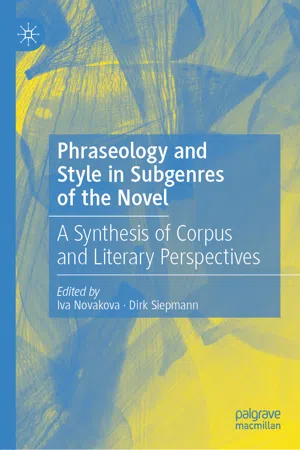2.1 Linguistic Approaches to Literature
Previous research in stylistics (e.g. Barthes 1966; Leech and Short 2007), corpus stylistics (Stubbs 2005; Fischer-Starcke 2010; Mahlberg 2013) and textometry (Brunet 1981)1 concentrated on characterizing the style(s) of various authors (e.g. Flaubert, Proust, Dickens, Austen). It showed that the bulk of the theoretical literature focuses on recurrent schemas (e.g. Todorov 1980; Lits 2011) found in their novels. On the other hand, research is scarce when it comes to fiction-specific lexico-grammatical patterns based on large corpora, which the present volume centers on. Our study first differentiates these patterns before proceeding to distinguishing them from other types of phraseological units.
While some literary scholars (e.g. Attridge 2004) and the general public tend to confer a special status on the language of literature, linguists generally agree that “literary language is not special or different, in that any formal feature termed ‘literary’ can be found in other discourses” (Burton and Carter 2006, 273). Countering the formalist claim that “defamiliarization” or “foregrounding” (Mukařovský 2014, 43) is the essence of literature and literary language, a strong case has been made that many works of literature contain “ordinary language” or have their “roots in everyday uses of language” (Leech 2014, 5–6). This has led to attempts at capturing the specificity of literary language in functional terms, using criteria such as medium-dependence, displaced interaction, and polysemy (Burton and Carter 2006, 272) or the “duplicity” (Scholes 1982, 23) of the various factors involved in the communication process (e.g. the difference between author and narrator).
If we adopt this view, the subjective impression of “literariness” (литepaтypнocть, Jakobson 1921) conveyed by even the shortest passage of imaginative prose would merely be an incidental phenomenon subordinate to the unfathomable rules of the artistic craft. Yet, significantly, this assumption of a functional difference without a formal correlative—a kind of linguistic epiphenomenon—is without parallel or precedent in linguistics. It may simply be due to the fact that literary language or the language of a particular literary genre have never been examined in their entirety. As mentioned earlier, the investigations have usually focused on a particular author’s style or individual texts as well as on the stylistic devices handed down from Greek antiquity. By turning both literary and linguistic traditions on their heads as it were, we are assuming that literariness does not primarily reside in any stylistic features peculiar to literary texts (e.g. metaphor, irony), but rather in their adherence to genre-internal conventions of idiomaticity. In other words, it is the statistically significant over-representation of particular general-language features that creates the subjective impression of literariness. It will be argued here that the essence of imaginative writing is not idiosyncracy or originality but a certain unobtrusive conventionality common to all instantiations of a particular literary genre during a given period, regardless of their literary status. Any attempt to pin down the notion of literariness must therefore consider the habitual “norm” (Coseriu 1975, 85–88) or the “idiom principle” (Sinclair 1991, 113) underlying specific genres if we are to succeed in determining how the “creativity principle” (Siepmann 2011, 68) and the “open-choice principle” (Sinclair 1991, 175) variously operate in specific texts. Moreover, Stubbs and Barth (2003, 79) demonstrated that “text types are distinguished by lexical and grammatical patterns.” They found that fiction, for example, is “characterized by a verbal style, by past tense verb forms and by frequent vocabulary from the lexical fields of saying, looking, thinking and wanting.” However, the study in question, apart from being based on a small corpus, was limited by its exclusive focus on the 200 most-frequently occurring multi-word strings in each genre. The results showed little evidence of lexical units of meaning capable of significantly impacting the reader’s conscious perceptions of texts. Similarly, Biber et al. (1999) identified a number of general fiction-specific grammatical features, such as the absence of participial relative clauses (606) or the frequent use of double genitives (309). Biber (1988) and Conrad and Biber (2001) also provided detailed multidimensional analyses of register variation linking situational characteristics to linguistic features and their functions but in which they failed to consider fiction-specific keywords or multi-word units.
2.2 Approaches to Idiomaticity and Phraseology
As we have just seen, while there is a dearth of studies on the lexico-grammatic nature of literary texts, many researchers have examined idiomatic combinations in other genres such as journalistic and scientific texts (Sinclair 1991, 2004; Hunston and Francis 2000; Hoey 2005; de Beaugrande 2005). While there is currently no consensus among authors on the resulting profusion of labels used to identify idiomaticity—such as “extended units of meaning” (Sinclair 2004), “constructions” (Goldberg 1995), “collostructions” (Stefanowitsch and Gries 2003), “collocations” (Hausmann 1979; Mel’čuk et al. 1995; Siepmann 2005), “lexical bundles” (Biber et al. 1999), “sequential patterns” (Quiniou et al. 2012), and “multi-words expressions” (Steyer and Brunner 2014)—there is nevertheless a growing convergence among these different approaches and labels that dispenses with the distinction between a grammar composed of rules and a lexicon consisting of words and phrases.
Thus, the Neofirthian approach, whose most accomplished proponent is undoubtedly Hoey (2005), advocates for a grammatical lexicon containing both grammatical combinations (“colligations”: e.g. GN + to be + about + V-ing) and lexical combinations (“collocations” clear motorway). This theory uses the concept of collocational “nests,” where the meaning is not compositio...
